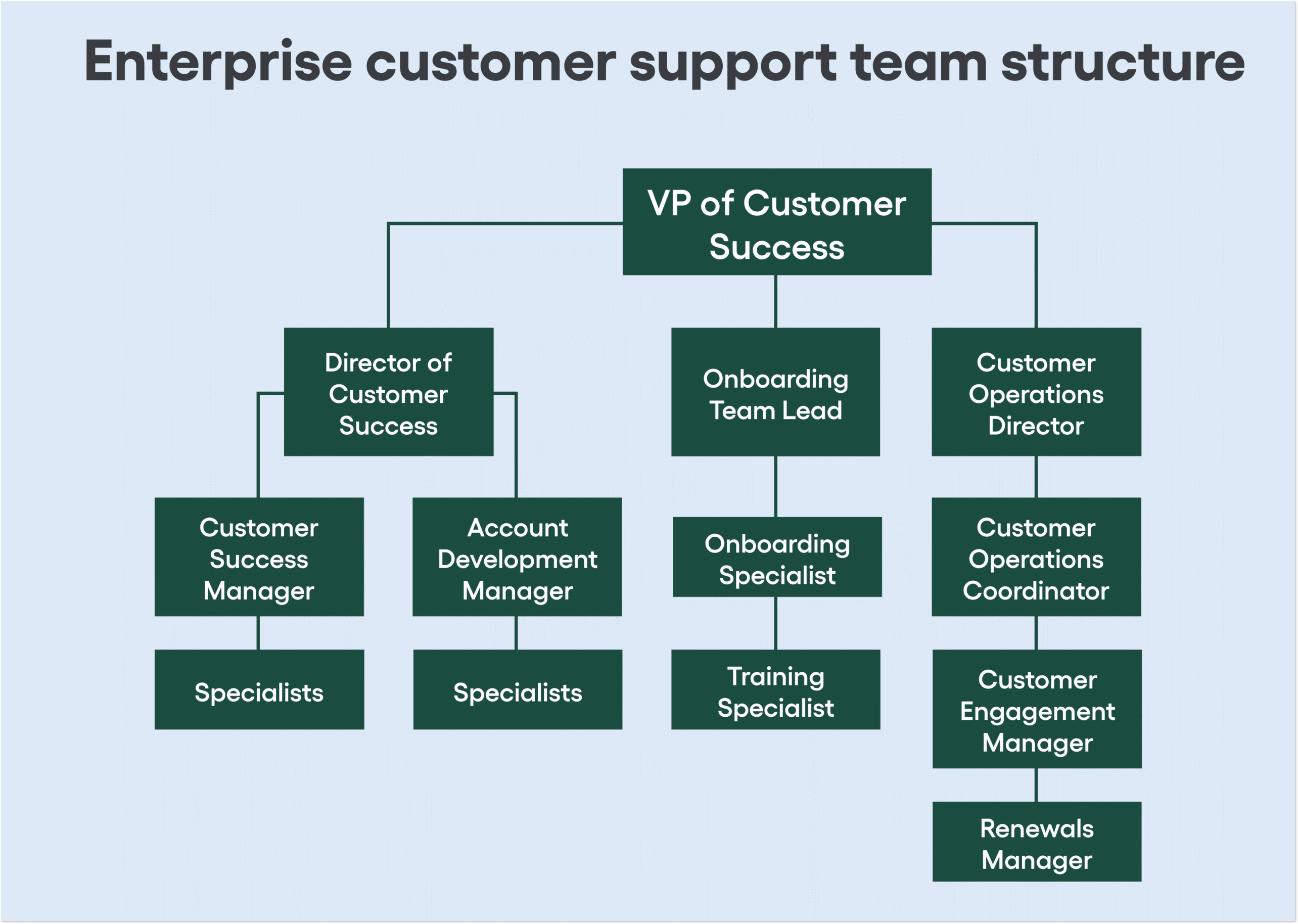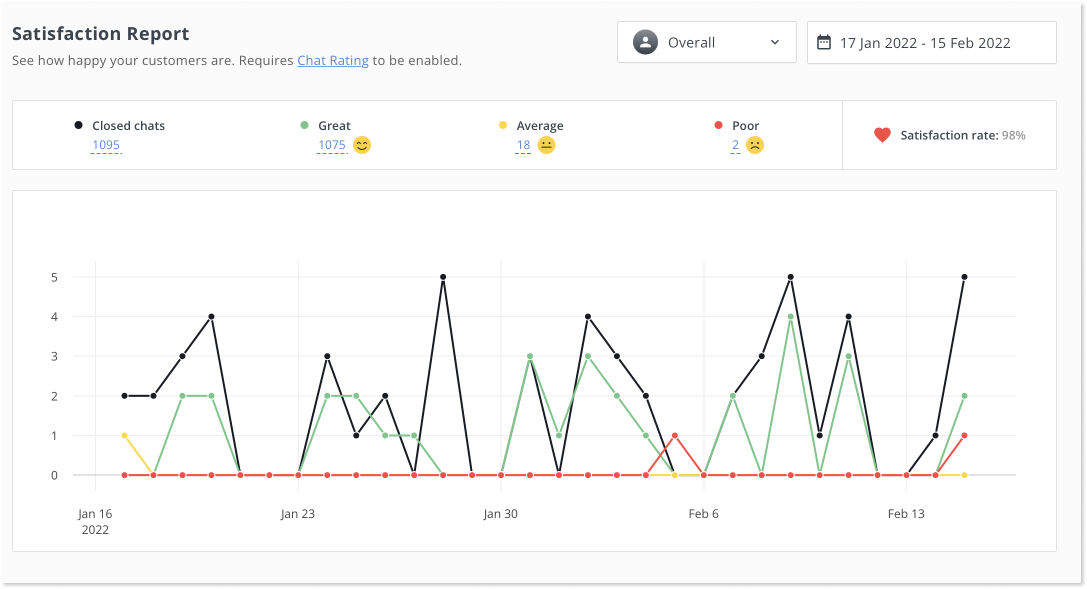How to Build a Robust Support Team: 7 Foolproof Tactics
Have a look at our article on how to build your customer support team and get some valuable tips right away.
Written by Anastasiia Khlystova

What are the key bottom lines of any industry? Attracting new customers, closing as many deals as possible, making clients happy, and retaining them. Marketing and sales teams usually handle the first two. But when it comes to users’ happiness, that’s where a support department takes the stage.
Think about your service strategy. Does it work like clockwork? Do you think it needs improvement? If you landed here, I guess you want to improve your customer support. And you are not alone. Approximately 72% of businesses claim that fine-tuning support is a top-of-mind priority.
A strong support team is at the heart of every success story. Who can help clients make the most of a product? Who can address their questions and concerns no matter what? That’s right—a highly trained support rep.
Following a certain plan is best if you want your customer service team to be remarkable. Don’t have any yet? Fear not—this is a crash course on creating a seamless support department.
What is a support team?
A customer support department consists of people who strive for an excellent customer experience. It’s a sympathetic team that puts each client’s concern first and is dedicated to helping clients achieve their goals.
Moreover, this powerful squad offers assistance to customers with onboarding, troubleshooting, or upgrading processes. When successful, a stellar support team nurtures customer relations even after a deal goes through.
If you think that a support department remains uninvolved in the company’s decision-making processes, it’s not true. A perfect support team is a part of the whole unit today. By joining other departments (marketing, sales, or developers), it’s possible to increase efficiency, save each other time, and deliver holistic service.
What should the support team structure look like?
When building a support team structure, remember there is no one-size-fits-all solution. What your department will look like depends on the type of your business, the size of the company, and the tricks that work best for you.
However, there are some common practices that I’m happy to share with you.
For startups and small businesses, a support team structure will be quite versatile and can include just three people:
- Customer Service Manager. They manage, organize, and provide support to clients.
- Customer Service Specialist. Their main job is to answer users’ non-technical questions like billing, onboarding, product use cases, or setup issues.
- Technical Support. They are the ones who deal with the most difficult technical questions when something is not working quite right.
These few customer service representatives you hire must be skilled in various areas as they may need to wear many hats. Usually, support agents in small teams heavily rely on automation tools, like chatbots, online forms, auto messages, etc.
You might hire more members for mid-sized companies to ensure each client gets enough attention. In this case, the support team structure may consist of five or more people:
- Director of Customer Success. The one who is in charge of the department.
- Customer Success Manager. This person is the right hand of the Director, they help to organize the process while also taking care of clients’ inquiries and guiding other reps.
- Account Development Manager. This person is responsible for the sales plan.
- Onboarding Specialist. They make sure that each user has everything they need to onboard successfully.
- Customer Operations Coordinator. They ensure that the support team complies with the policies and procedures of the organization.
If you have several different products, consider building a subteam around each. Some companies split the team according to the geographic region. Others divide them according to different stages in the user’s journey.
For enterprise-level companies, the customer service team structure may vary from business to business. But here is a quick graph to illustrate what it may look like.

Here, the approach might be similar to mid-level ventures where structuring is organized around specific products, sales channels, or geographic regions. However, big companies can go even further and make the structure more granular.
What makes a good support team?
Creating an effective support team requires all team members to have the proper qualifications to perform to the best of their abilities. These are our TOP 6 characteristics describing the very best support team:
- Proactivity: By delivering proactive customer service, you can show your willingness to help clients before an issue even pops up. Such an approach ensures clients feel appreciated and heard.
- Patience: If you, as a service agent, answer customer questions with impatience or frustration, nothing will work out. At the end of the day, a support department is a place where people are supposed to be assisted with understanding and respect.
- A problem-solving ability: Whether it’s a management issue (identifying budget priorities, proving ROI, etc.) or a tricky question that needs to be handled right now, a seasoned expert should be able to cope with all of it. Support problem-solving techniques are what a support team member should practice occasionally.
- Teamwork: Combining forces for your clients to get the greatest service develops critical thinking, promotes easy knowledge sharing between employees, and boosts productivity.
- Pleasant interaction: a chatbot or any other computer might deal with some common requests just fine. But human communication is a must-have when it comes to more complex issues. Be nice and friendly to demonstrate trust and the readiness to go the extra mile for a client.
- In-depth knowledge: your staff can do special customer service training (personality tests, educational videos, role plays, etc.), but sometimes there’s a need for additional details on a subscription process or a simple, timely apology. Ensure your support team members know all the ins and outs of what you offer. Otherwise, irritation is around the corner.
Benefits of an effective support team
Let’s kick things off by talking about why you having a top-notch support team is like having a secret weapon for your business. The perks go beyond just answering queries. A robust support team means:
- Satisfaction: Happy clients are repeat clients, and an effective support team the one ensures people feel heard and valued.
- Loyal customers: Clients are likelier to stick around when your support team is on point. Loyalty is built on trust, and great support builds just that.
- Positive word of mouth: Have you ever found yourself recommending a brand to friends and family because you are completely satisfied with the service and product? A satisfied client becomes your unofficial brand ambassador.
Therefore, if you take care about your support team, monitor agent performance and improve agent productivity — you’ll get big return on your investment.
Training for success
Now, superheroes aren’t born; they’re made. The same goes for your support team. Here are some tactics to get support troops from ordinary to extraordinary:
- Understanding customer needs and expectations: Your team needs to be mind-readers. Well, not exactly, but close. Understanding what the client wants and expects is Support 101. It’s not just about solving a problem; it’s about making people feel heard and understood.
- Practicing problem-solving techniques: Your support team should be confident in coping with any situation. Thus, equip them with problem-solving techniques: teach them to analyze, strategize, and come up with solutions faster than a speeding bullet.
- Developing writing skills to communicate effectively: In the world of support, the pen is mightier than the sword. Clear, concise, and courteous communication is the key. No one likes a support email that looks unpresentable and reads like a novel.
- Enhancing product knowledge: Knowing your product inside out is like having a shield against clients’ confusion. The support team should be walking encyclopedias of the product or service they represent. That way, they can tackle key questions faster than you can say, “I don’t know, let me check.”
And there you have it! Yeah, the soft skills of individual employees are, of course, critical. But let’s zoom out and see what it takes for the support team to work as one at 110%.
7 steps on how to create a thriving customer support team
Here you are, all set to build a support team from scratch. Take a look at these 7 building blocks that make for a solid foundation.
1. Set the core metrics
Before you start, ask yourself a question about what great customer service means to you. This is a crucial pivot point to get everyone on the same page in the support team. Plus, it’s an opportunity to work out your customer service philosophy.
When you’re breaking new ground, define the quality standards of service you’re going to provide. Once you finish this, you’ll have a set of KPIs to measure your team’s performance.
We’ve researched that matter, and according to SE Ranking support team leader Anna, their team has four criteria when it comes to performance evaluation:
1. Customer satisfaction scores. They track this rate with the help of HelpCrunch detailed reports, and it depends on the percentage of closed and rated chats. SE Ranking’s end goal is 98% satisfied clients, which they successfully achieve.

2. Reviews. At SE Ranking, their support team must attract at least ten monthly reviews on G2 and other review websites. This number is also very subjective for every business, but it is always a good idea to make it the core KPI.
3. Demos. Demos are essential for attracting and converting high-quality leads because they are an excellent opportunity to showcase all the benefits of your business right there. That’s why it makes sense to specify the number of monthly demos and the conversion rate from demo to subscription- or payment based on your overall number of support requests.
4. Upsell activities. You can pay something extra for some additional work. Even though upselling is not a direct duty of your customer support team members, you can encourage them to do it. For instance, if they do 5-10 upsells per month, reward it in some way.
2. Empower your team
Hiring suitable customer support representatives requires special skills of your recruitment team. To hire customer support team who will elevate your customer service and boost revenue, your recruitment team should first pick the right candidates, evaluate their skills, and then onboard new employees properly. But what happens next?
When you hire new people, don’t put limitations on their capabilities. Let them express creativity, feel their impact, and make decisions when interacting with clients. Training an entire team with decision-making authority and influencing the business image directly can make a massive difference between just okay support and five-star reviews. This should become the company culture.
Provide your service staff with a proper toolset so that they perform their tasks sufficiently, with a smooth workflow. Speaking of customer service tools available right now, you can choose whatever suits your needs: live chat, chatbot, email, or knowledge base.
HelpCrunch, an omnichannel customer service software, is perfect for a busy support team and involves all the necessary internal tools. Interact with your clients via live chat, chatbot, or email, and store valuable info under the same dashboard.
Since users are tech-savvier today, self-service will be easier for them with a knowledge base software solution (and as a bonus, you can lessen the load off your support team). Plus, the knowledge base is integrated into the chat widget now. So, finding the solution is a snap.

3. Become a motivator
Happy support reps lead to happy customers. More than 70% of clients say they will share a good service experience with others. So, why not move in this direction by encouraging your support department first?
There are a dozen ways to motivate your team members and make them arrive to work in positive humor:
- Provide real-time feedback: Take advantage of what your clients say and use their reviews as positive reinforcement throughout the day. Let your support team know they do a great job.
- Corporate events and team-building exercises: Try to arrange those get-togethers somewhere outside your office, wear casual clothes, and come up with some fun stuff. This will help your support team unwind, boost employee morale, and break the ice.
- Create an incentive program: Offer higher wages and promotions, set up awesome perks for an amount of successfully finished chats by the end of the day, or ideal performance. Plus, be okay with unlimited sick leaves, a week off at the end of December, etc. There can be as many options as you can think of.
- Explain how to make amends after a negative interaction: A support position isn’t a piece of cake. People have different backgrounds and tempers. And a support team absorbs the negativity like a sponge. As a manager, tell your staff how to make this right after a bad experience with a client. This can serve as a strong motivation to achieve a better result next time.
- Build a friendly competition: Gamification can turn hard work into fun. For instance, incorporate various skill levels for support agents to shoot for and compete. Give a ‘Speed King’ trophy for the fastest issue resolution and a ‘Customer Guru’ badge for an excellent satisfaction chat rate.
4. Mind quick responses
Who wants to waste time listening to on-hold music or waiting for a message from a support team? Nobody. About 53% of users claim they become irritated if they don’t talk to a real person right away.
While email support isn’t as prompt as we wish, going for a live chat option can be a way out. A service team can use canned responses to save themselves much time and meet clients’ expectations for response times (as we do, you can check the image below).
Thanks to the enhanced capabilities of HelpCrunch live chat, one support agent can handle up to 5 conversations simultaneously. It’s better to choose speedy replies to satisfy clients rather than cry over their leave.

Here’s when practical experience won’t hurt. Try the typing speed test to take your support team’s typing speed skills to the next level. It’s not only fun but also productive. Train support agents so that clients receive answers faster. Moreover, consider various online and offline workshops or even special literature to read.
5. Listen to your customers
Though this statement may seem slightly obvious, many businesses disregard listening skills. However, understanding your customers’ expectations is always beneficial.
First of all, you can tune up a customer-first strategy according to their wishes. Clients can even serve as beta testers of your product or service and find bugs to fix if you organize proper feedback loops. Second of all, your support team will learn how to gather feedback and turn it into an advantage. Their opinions are a valuable data source that can help you realize how they feel about your stuff.
Besides, you can utilize those reviews to guide your business and marketing processes. Last but not least is appreciation and, as a result, massive word of mouth. All of it is worth giving it a shot, isn’t it?
An online travel agency, Booking.com, has already given it a try. They use these methods to catch up with people and find out what they think of the services:
- Usability tests
- Online surveys
- User research
- Street-level user testing
6. Promote cross-departmental collaboration
A support team needs a complete picture of the customer’s journey. They face only one side of the coin without seeing the client’s decisions before the final purchase. Sales and marketing departments handle other equally important aspects of your client’s buying process instead. Should a support team partner up with them? Sure!
Make knowledge sharing and learning a part of your daily routine. It will help your support team cooperate and transfer positive vibes to clients. Clear internal communication will set the tone for how staff and management should treat each other.
It’s always possible to recommend upgrade solutions to customers, but catching the right timing is more critical. If support reps work together with marketing and product teams, they will know what to cross-sell or upsell enticingly.
On the flip side, marketing and sales can learn stuff from a support department. Let your support team highlight the most current clients’ needs and coach the others on how to format their content.
We at HelpCrunch prefer working as one strong unit. For instance, our customer success managers (CSMs) usually transfer clients directly to the sales rep when they want a demo or upgrade. Besides, our developer team helps a lot. They added a Slack integration, meaning client messages get right into the Slack channel where sales, marketing, devs, and CSMs can see them and act accordingly.
7. Turn advanced technologies to your advantage
Take time to know your clientele. Showing them you care is even better than offering something for free. Sure, people like to be remembered. And your task is to document every customer interaction, feature request, or anything else so that you can tailor accurate customer service.
An awesome example of a customer-focused company is IKEA. This Swedish furniture brand stands out with its forward-thinking approach and innovations. One of their mind-blowing products is a specially designed phone app, IKEA Place. Owing to AR technologies it lets people see how a piece of furniture can fit within the interior of their living space.
IKEA utilizes this technology to understand better what items drive purchase behavior to promote the greatest product benefits. For instance, they can collect relative data for retargeting campaigns and create social media or email marketing segments.

Final thoughts
Building a support team that efficiently caters to customers’ needs might be a tough nut to crack. But if you put all the tips we’ve discussed today to work, you will succeed. Just bear the key takeaways in mind: be proactive, motivate your team members, listen to your clients, be honest and transparent, and leverage the right tools.
Sign up for HelpCrunch, test its advanced features (a free 14-day trial is available), and create a support dream team.





